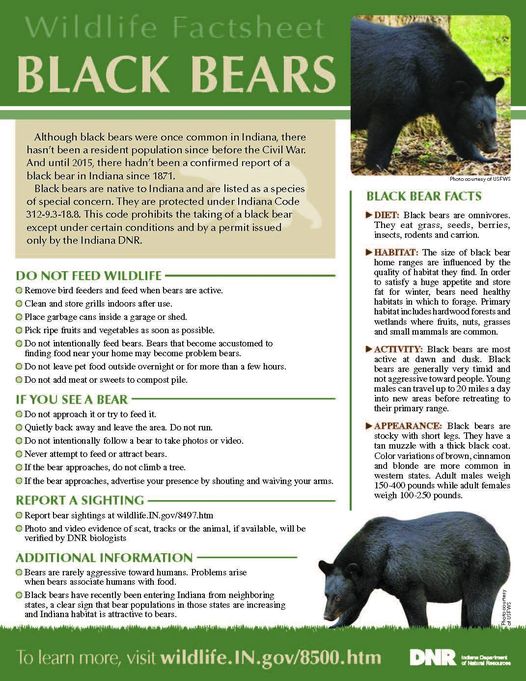
free genealogy since 1996
Allen County, Indiana Genealogy
Allen County, Indiana Wildlife - Animals
Black Bears
- Bear cub mentioned in 1859 newspaper clipping 1859 - Fort Wayne in Old Times - General Harmar's Campaign in 1790 - Miami Village - bear cub Dawson's Fort Wayne Weekly Times, Fort Wayne, Indiana, Saturday, September 10, 1859, Page 1.
Black bears (Ursus americanus) were historically abundant across Indiana, excluding the northwest portions of the state dominated by prairie. Unregulated hunting and habitat loss caused black bears to be extirpated from Indiana and much of the Midwest by 1850. Today, black bear populations are expanding and they may pass through Indiana from established populations in adjacent states. In recent years, four black bears have been confirmed (2015, 2016, 2018, 2021) in Indiana. Copied from Black Bear at the Indiana Department of Natural Resources.
-
A couple of 1908 books of fiction about a boy growing up in early Indiana bear and Indian country.
Yesterday in Indiana History, 1901, "Bears of Blue River" was published by Charles Major of Shelbyville, Indiana. The...
Posted by Indiana Historical Bureau on Monday, September 8, 2014Monday, September 8, 2014 post by the Indiana Historical Bureau on Facebook:
Yesterday in Indiana History, 1901, "Bears of Blue River" was published by Charles Major of Shelbyville, Indiana. The story about a boy growing up in the woods of early Indiana has become a classic in children's literature.
The bears of Blue River by Major, Charles, 1856-1913 Publication date 1908 on Archive.org.
The original book was 326 pages, a 294 page version The bears of Blue River was published in 1913 and 114 page version The bears of Blue River in 2011.
A comment to the Facebook post mentioned a sequel: Uncle Tom Andy Bill: A Story of Bears and Indian Treasure discussed on Goodreads.
Uncle Tom Andy Bill; a story of bears and Indian treasureby Major, Charles, 1856-1913 Publication date 1908 on Archive.org. The original was 426 pages, a 1993 version of Uncle Tom Andy Bill is 352 pages.
June 12, 2015 post by the Indiana DNR Division of Fish and Wildlife on Facebook:
Here's some exciting news! The first wild black bear to wander into Indiana since 1871 was confirmed in St. Joseph County.
Black bears eat mostly plants and berries this time of year, and especially love bird seed due to the high fat content. They are still a wild animal, so keep your distance, but feel free to observe from afar and send any photos or sightings to dfwinput@dnr.in.gov.
Entire story: Wandering black bear confirmed in St. Joseph County [ Archived on the Internet Archive Wayback Machine ]
Photo Courtesy of: USFWS (not of the bear currently in Indiana)
December 3, 2018 post by the Indiana DNR Division of Fish and Wildlife on Facebook:
A trail camera photo of a black bear from November 23 in Clark County, Indiana was recently confirmed by DNR staff. The bear can be seen walking along the edge of a standing soybean field. This is likely the same bear that was reported in the New Albany area on Nov 18 after being struck by a vehicle. These reports are 10 miles apart indicating that the bear was still active and moving after the accident. A black bear is not cause for concern, but citizens are encouraged to be BearWise to minimize potential conflicts and not leave out food for the bear or attempt to approach it. Visit bearwise.org for tips on living with black bears and read our factsheet below for bear information. Learn more about black bears, report sightings, and download the pdf of the factsheet at our black bear webpage: Black Bear
June 27, 2021 post by the Indiana Department of Natural Resources on Facebook:
CONFIRMED: Black bear in Vanderburgh County
DNR biologists have confirmed a black bear sighting that occurred in northeast Vanderburgh County before sunrise this morning. The closest town to the location is Elberfeld, in Warrick County.
Biologists confirmed the bear from photos taken by the landowner.
“This is Indiana’s fourth confirmed black bear,” said Brad Westrich, DNR mammalogist. “With expanding bear populations in neighboring states, this is expected.
“Human-bear conflicts can be avoided if you remove or secure potential food sources from your yard. Bears can smell food from more than a mile away.”
Black bears are rarely aggressive toward humans.
If you see a black bear:
— Do not feed it.
— Observe it from a distance.
— Do not climb a tree.
— Advertise your presence by shouting and waving your arms and backing slowly away.
— Report bear sightings to the Indiana Division of Fish & Wildlife at Report A MammalMost problems that occur with bears arise when bears associate food sources with humans and lose their fear of people.
More guidelines for reducing or eliminating the potential for bear-human conflicts:
— Remove bird feeders and bird food if a bear is reported in your area.
— Clean and store away grills after use.
— Eliminate food attractants by placing garbage cans inside a garage or shed.
— Pick ripe fruits and vegetable as soon as possible or place an electric fence around them to ensure bears cannot reach them.
— Consolidate beehives you may have and place an electric fence around them. — Don't leave pet food outside overnight. — Don't add meat or sweets to a compost pile.
— Don't climb a tree if you encounter a bear; wait in a vehicle or building for the bear to leave the area.More information on black bears is at Black Bear
As winter fades and spring begins, black bears emerge from their dens and new cubs get their first glimpses of the...
Posted by U.S. Department of the Interior on Saturday, March 16, 2024Saturday, March 16, 2024 post by the U.S. Department of the Interior on Facebook:
As winter fades and spring begins, black bears emerge from their dens and new cubs get their first glimpses of the outside world.
For the first several weeks, the bears wander lazily, snacking on fresh leaves and stealing nut caches from squirrels. Their appetites increase as berries and acorns become abundant and the cubs quickly learn survival skills like foraging and climbing. Not everyone can get by on their cute looks alone.
Photo at Shenandoah National Park by Joel Brown
Family portrait! 📸 Seeing a bear in the wild is a special treat for visitors on public lands. While it is an exciting...
Posted by U.S. Department of the Interior on Friday, June 7, 2024Friday, June 7, 2024 post by the U.S. Department of the Interior on Facebook:
Family portrait!
Seeing a bear in the wild is a special treat for visitors on public lands. While it is an exciting moment, it is important to remember that these bears are wild and can be dangerous.
If you see a bear, remember you are a visitor in its home. Keeping your distance and not surprising bears are some of the most important things you can do to avoid an encounter. Pay attention to your surroundings and make a special effort to be noticeable in bear country.
Learn more about staying safe in bear country: Staying Safe Around Bears
Photo by Taylor Albright
Our gift for you today: the chance to squee over these cute bear cubs. As the days reach their shortest, the black bears at Rio Mora National Wildlife Refuge in New Mexico work hard to finish building the fat stores they worked on all season. Once food becomes unavailable, they make their way to their dens for a good slumber. Momma bear will get her cubs through their first winter and send them on their way in spring. Video Description: A mother bear ambles along a refuge service road while her two cubs run ahead of her. USFWS
Posted by U.S. Fish and Wildlife Service on Thursday, December 19, 2024Thursday, December 19, 2024 post by the U.S. Fish and Wildlife Service on Facebook:
Our gift for you today: the chance to squee over these cute bear cubs.
As the days reach their shortest, the black bears at Rio Mora National Wildlife Refuge in New Mexico work hard to finish building the fat stores they worked on all season. Once food becomes unavailable, they make their way to their dens for a good slumber. Momma bear will get her cubs through their first winter and send them on their way in spring.
Video Description: A mother bear ambles along a refuge service road while her two cubs run ahead of her. USFWS
Would you like to see black bears back home in Indiana?
Posted by INCA Indiana Conservation Alliance on Thursday, September 4, 2025Thursday, September 4, 2025 post by the INCA Indiana Conservation Alliance on Facebook:
Would you like to see black bears back home in Indiana?
Cicinnati Zoo Black Bear Exhibit
We’re excited to share our collaboration with the Cincinnati Zoo & Botanical Garden ! Together, we’ve worked to include...
Posted by Myaamia Center on Monday, October 27, 2025Monday, October 27, 2025 post by Myaamia Center on Facebook:
We’re excited to share our collaboration with the Cincinnati Zoo & Botanical Garden ! Together, we’ve worked to include Myaamia ecological perspectives in their North America habitat. The Zoo recently opened its new black bear habitat, featuring two adorable mahkooki ‘black bears,’ along with Myaamia language and information about the lunar calendar system. The lunar calendar even includes two months related to mahkooki. [ Sign says bears can run 30 mph, are excellent swimmers, and tree climbers! ]
Plan a visit to the Cincinnati Zoo to meet the mahkooki and practice your Myaamiaataweenki ‘Miami language’ while you’re there!
Big bear sightings in Ohio SW of Columbus.
Hunters in southeastern Ohio are on high alert after multiple sightings of a massive black bear roaming near the Wayne...
Posted by The Hunting Report on Sunday, October 26, 2025Sunday, October 26, 2025 post by The Hunting Report on Facebook:
Hunters in southeastern Ohio are on high alert after multiple sightings of a massive black bear roaming near the Wayne National Forest line.
According to Ohio DNR, the bear — now nicknamed “Big Clyde” by locals — was first captured on a trail camera late Tuesday night on a private property near Township Road 211. Officials say the bear appears to be well over 400 pounds, making it one of the largest ever documented in the region.
“He came walking right under my camera like he owned the woods,” said one hunter who shared a photo of the encounter. “You can see how wide he is just by the way the trees behind him look small. I’ve never seen anything like it in Ohio.”
DNR confirmed three separate trail cam submissions within a five-mile radius over a 48-hour period. All photos were taken between 8:00 PM and 4:00 AM, suggesting the bear is moving mostly at night and sticking close to thick cover and creek bottoms.
“We’re asking hunters and landowners to use caution,” said one wildlife officer. “He’s not being aggressive, but an animal this size can cover ground fast. Give him space.” [ Cincinnati Zoo sign above says bears can run 30 mph ]
Locals say rumors of a “giant black bear” have floated around for years, but this is the first time multiple cameras and landowners have confirmed the same animal.
